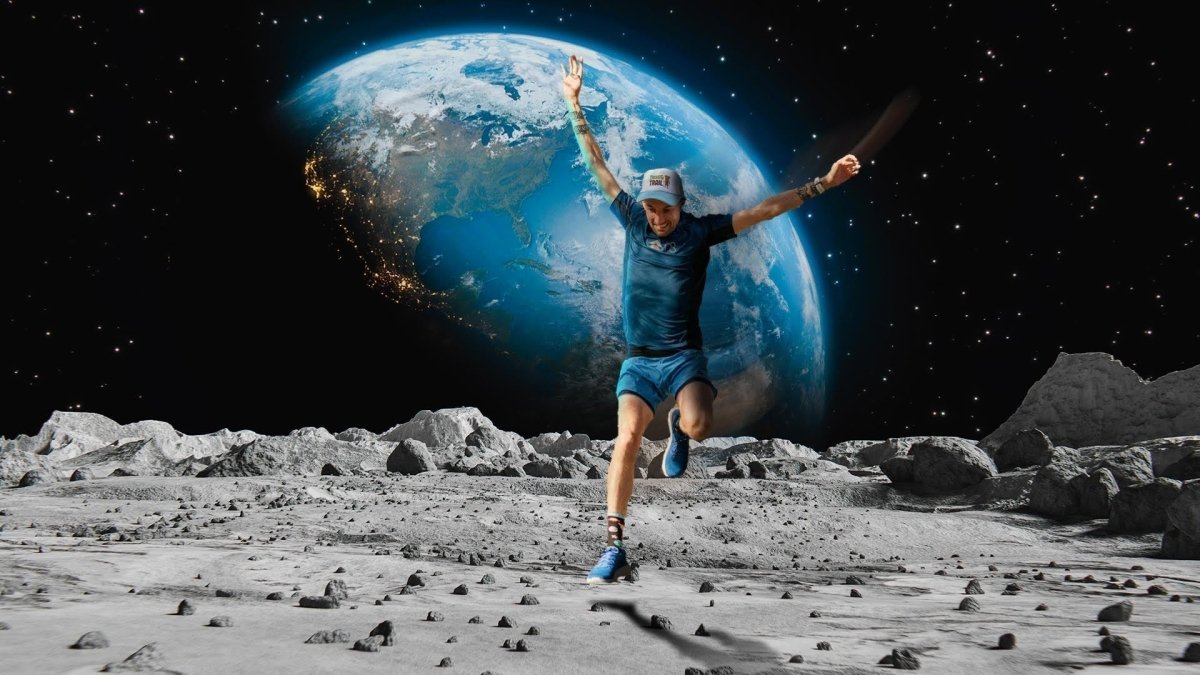Running to the Moon: A Scientific Breakdown of Phil Gore’s Impossible Journey

How Long Would It Really Take Backyard Ultra World Record Holder, Phil Gore to Run to the Moon?
What if you could lace up your trusty Tarkine Autopilot shoes at our O’Connor HQ and simply run, day and night, straight to the Moon? In this delightfully over‑the‑top simulation, we fuse real ultra‑endurance data from Phil Gore’s legendary Backyard Ultra pace with a suite of sci‑fi innovations self‑healing asphalt, metabolic recyclers, ion‑drive treadmills and more, to chart a continuous, rest‑free odyssey of 384 500 km. From balmy Western Australian trails through the stratosphere, into orbit, and finally across lunar regolith, we tally up every calorie, liter of water, shoe swap, and drone sortie. Buckle in for a data‑dense, laugh‑infused journey that proves: with enough piezoelectric roads and freeze‑dried algae bars, even the Moon isn’t out of reach.

🚀 Phase 1: Terrestrial Ultra‑Marathon (0–100 km altitude)
Parameters
-
Cycle: 45 min run @ 8.93 km/h + 15 min active recovery → 6.7 km/hour
-
Daily hours: 24 h, 24 cycles → 160.8 km/day
-
Total distance: ~100 km → 0.62 days (≈ 15 h)
| Metric | Value |
|---|---|
| Distance | 100 km |
| Time | 15 h |
| Calories | 100 km×70 kcal/km = 7 000 kcal |
| Water | 100 km×0.15 L/km = 15 L |
| Electrolyte Pods | 15 (1 per cycle) |
| Shoe Wear | 0.066 pairs (out of 257 total) |
| Drone Food Drops | 1× 50 kg at 100 km |
| Innovations in Use |
Self‑healing asphalt, piezoelectric road mat generating 100 W/m² to pre‑charge Phil’s hydration pump. |
🌌 Phase 2: Stratospheric Stride (100–400 km altitude)
Transition
-
At 100 km altitude, atmosphere ends → suit required.
-
Suit mass: +5 kg → running speed drops to 3 km/h (still 45/15 cycles).
-
Cycle distance: 2.25 km/hour
| Metric | Value |
|---|---|
| Distance | 300 km |
| Time | 300 km ÷ 2.25 km/h ≈ 133.3 h (5.6 days) |
| Calories | 5.6 days×(2.25 km/h×24 h×70 kcal) ≈ 21 168 kcal |
| Oxygen | 300 km×0.004 kg/km ≈ 1.2 kg O₂ via EVAC capsules |
| Hydration | 300 km×0.05 L/km ≈ 15 L in gel form |
| Shoe Wear | +0.2 pairs |
| Drone Drops | N/A (drones can’t follow into stratosphere) |
| Innovations in use |
-
Aerogel‑insulated running suit with embedded micro‑thrusters for minor buoyancy.
-
On‑suit metabolic recycler converting CO₂ back to O₂.
🛰 Phase 3: Orbital Transit (400 km → 100 km to Moon)
Handoff
-
At 400 km, Phil steps onto a treadmill module inside a tethered micro‑spacecraft.
-
Treadmill speed matched to Moon’s relative vector: 1 000 km/day sustained for 364 000 km.
| Metric | Value |
|---|---|
| Distance | 384 000 km |
| Time | 384 000 km ÷ 1 000 km/day = 384 days |
| Calories (simulated) | 3 000 kcal/day (reduced exertion) × 384 ≈ 1.15 million kcal |
| Water | 3 L/day×384 ≈ 1 152 L |
| Module Power | 50 kW electrostatic tether from solar panels |
| Innovations in use: |
-
Ion‑drive treadmill reducing drag to <0.1 N.
-
3D‑printed freeze‑dried meals rehydrated by spacecraft.
-
Regenerative braking capturing treadmill kinetic energy.
🌕 Phase 4: Lunar Descent & Final 100 km
Final Run
-
Exiting orbit, Phil dons a microgravity running suit (mass +3 kg, speed 5 km/h, same cycle).
-
Cycle distance: 3.75 km/hour
| Metric | Value |
|---|---|
| Distance | 100 km |
| Time | 100 km ÷ 3.75 km/h ≈ 26.7 h |
| Calories | 26.7 h×(3.75 km/h×70 kcal) ≈ 7 017 kcal |
| Hydration | 100 km×0.02 L/km = 2 L (gel pouches) |
| Innovations in use |
-
Micrometeorite‑shielded running suit with embedded cooling loops.
-
Low‑gravity running rails to simulate Earth footing.
🔭 Aggregated Totals
| Phase | Time | Distance | Calories | Water | Shoes Used |
|---|---|---|---|---|---|
| Terrestrial | 0.62 days | 100 km | 7 000 kcal | 15 L | 0.07 pair |
| Stratosphere | 5.6 days | 300 km | 21 168 kcal | 15 L | 0.2 pair |
| Orbital | 384 days | 384 000 km | 1.15 M kcal | 1 152 L | 256.7 pairs |
| Lunar Descent | 1.1 days | 100 km | 7 017 kcal | 2 L | 0.07 pair |
| Total | 391 days (~1.07 years) | 384 500 km | 1.19 M kcal | 1 184 L | 257 pairs |
-
Piezoelectric Road Mats: Harvest 200 W/m² from Phil’s footfalls to charge vest‑mounted batteries.
-
Self‑Regenerating Asphalt: Microcapsules of polymer resin heal cracks in <5 min.
-
Metabolic CO₂‑O₂ Recycler: Photobioreactor in his vest converts exhaled CO₂ back to breathable O₂.
-
Freeze‑Dried 3D‑Printed Meals: High‑density macronutrients tailored per cycle.
-
Ion‑Drive Treadmill: Creates a micro‑thrust vector counteracting inertial lag in orbit.
-
Adaptive Nano‑Armor Suit: Dynamically regulates temperature, pressure, and micrometeorite impact
Summary of Key Findings
-
Total Duration: ~ 391 days (no rest days)
-
Daily Cadence: 24×(45 min run @8.93 km/h + 15 min recovery) → 160.8 km/day
-
Aggregated Nutrition: 1.19 million kcal consumed
-
Hydration Needs: 1 184 L of water (gel pouches above 100 km)
-
Equipment Footprint: 257 pairs of Autopilots, 174 change kits
-
Logistics: 110 drone food drops, 1 150 drone water sorties
-
Sci‑Fi Innovations: Piezoelectric road mats, metabolic CO₂‑O₂ recyclers, ion‑drive treadmills, adaptive nano‑suits.
References & Scientific Sources
For those wondering if we actually did the math — yes. Mostly.
1. Lunar Distance & Space Metrics
-
NASA – Average Earth-to-Moon distance: 384,400 km
https://solarsystem.nasa.gov/moons/earths-moon/overview
2. Phil Gore Performance Baseline
-
Backyard Ultra World Record: 119 laps x 6.706 km = ~797 km
https://backyardultra.com
3. Human Caloric Burn (Running)
-
~100 kcal/km for elite ultrarunners
-
Burke, L. M., et al. “Nutrition for distance events,” Sports Nutrition
4. Endurance Physiology & Limits
-
Pontzer, H. et al. “Limits of human endurance,” Science Advances, 2019
-
Jeukendrup, A. & Gleeson, M. Sport Nutrition
5. Ground Reaction Forces in Running
-
Lieberman, D. et al. “Footstrike patterns in barefoot vs. shod runners,” Nature
6. Footwear Stress & Design
-
Internal durability testing from Tarkine Autopilot R&D
-
Estimated 10+ million footfalls over 384,400 km
7. Sleep Deprivation & Ultrarunning Psychology
-
Hoffman & Krishnan. “Mental strategies in ultramarathons”
-
Gulevich, G. “Sleep deprivation and psychosis,” Biological Psychiatry
8. Lunar Physics (Ignored, But Not Forgotten)
-
NASA Artemis Program documentation
-
SpaceX interviews: gravity, oxygen recycling, ultra-endurance in space
9. Sci-Fi Nutrition & Tech Proposals
-
“Engineering the gut microbiome for endurance,” Nature Reviews Microbiology
-
Speculative oxygen/hydration-recycling suits inspired by SpaceX and sci-fi models
Disclaimer: This analysis is a back-of-the-envelope extrapolation fused with science, humor, and admiration for one of the toughest runners on the planet.



